Waste Classification, Management, and Legal Requirements Report
VerifiedAdded on 2022/11/13
|20
|5175
|198
Report
AI Summary
This report critically examines the significance and consequences of waste classification systems, focusing on South African and international examples. It explores the role of classification in defining waste, differentiating between hazardous and general waste, and grouping waste streams. The report highlights the benefits of classification, including facilitating the interpretation of definitions, defining the scope of inventories, identifying waste generators, providing data sources, enhancing national reputation, enabling cost calculations, assessing efficiency, and setting up legal requirements for a clean environment. The analysis emphasizes the implications of classification on legal requirements for waste management, including duties of waste transporters, managers, and generators, disposal requirements, and waste management activity listings. The report underscores the importance of classification in achieving sustainable development, resource efficiency, and effective waste management strategies.
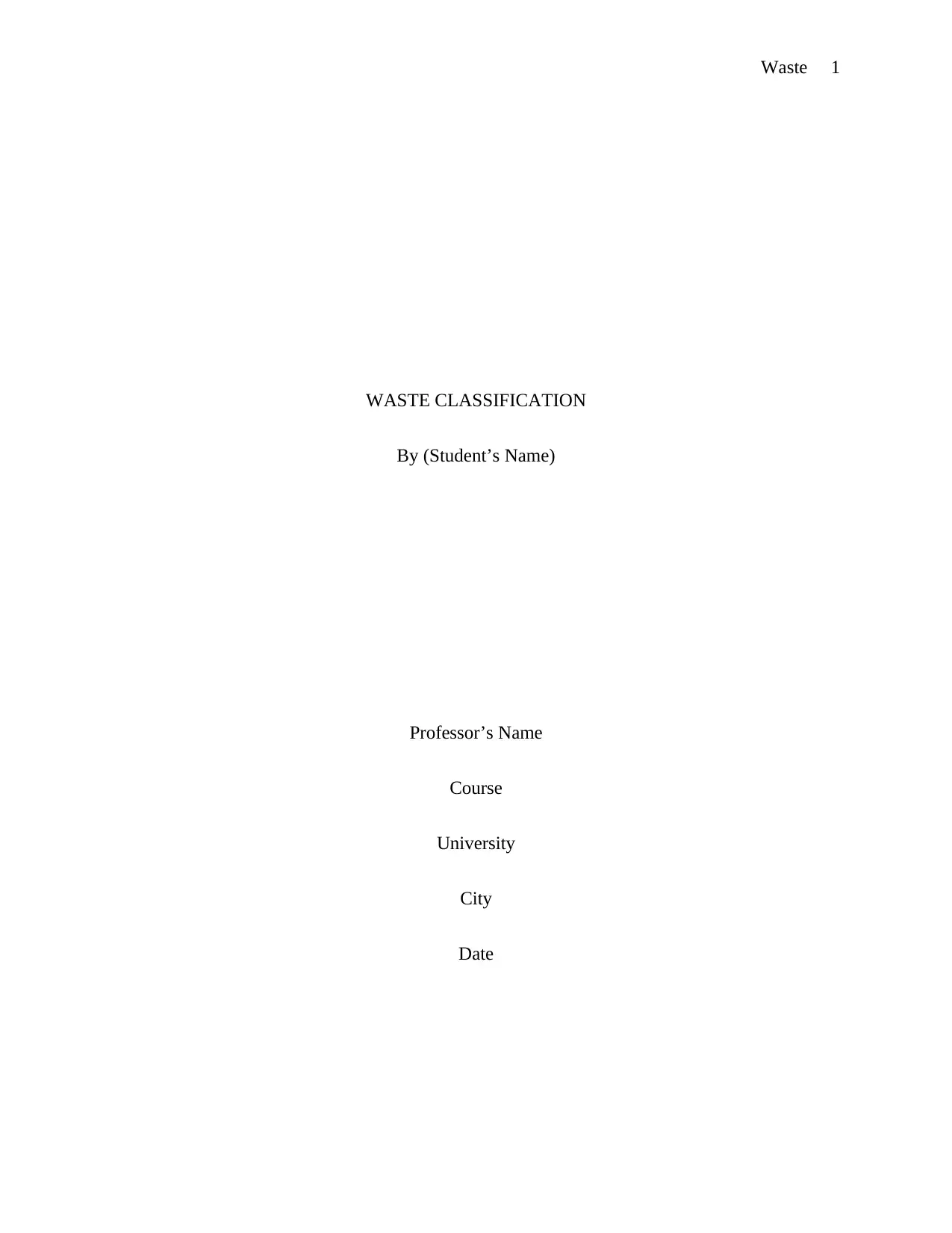
Waste 1
WASTE CLASSIFICATION
By (Student’s Name)
Professor’s Name
Course
University
City
Date
WASTE CLASSIFICATION
By (Student’s Name)
Professor’s Name
Course
University
City
Date
Paraphrase This Document
Need a fresh take? Get an instant paraphrase of this document with our AI Paraphraser
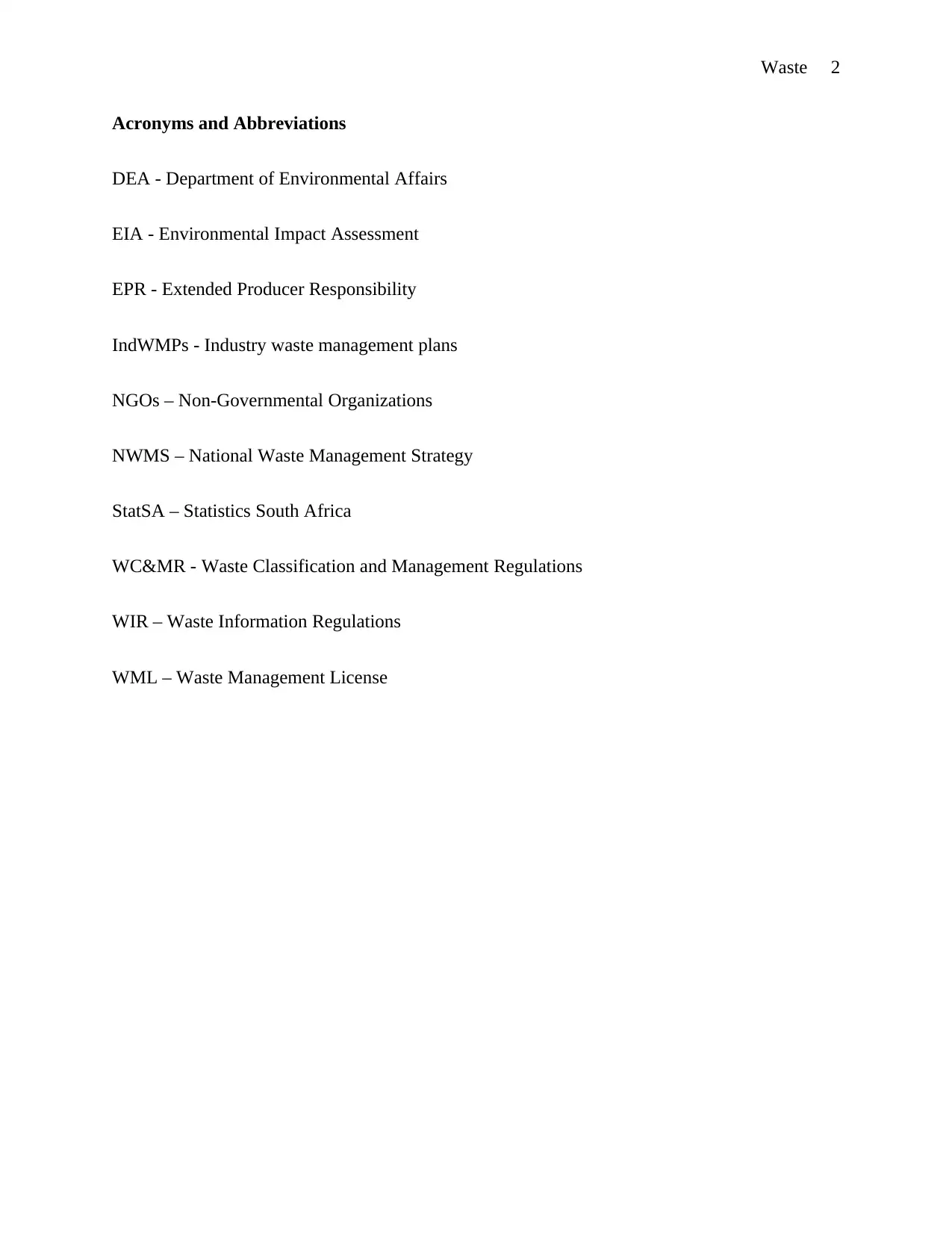
Waste 2
Acronyms and Abbreviations
DEA - Department of Environmental Affairs
EIA - Environmental Impact Assessment
EPR - Extended Producer Responsibility
IndWMPs - Industry waste management plans
NGOs – Non-Governmental Organizations
NWMS – National Waste Management Strategy
StatSA – Statistics South Africa
WC&MR - Waste Classification and Management Regulations
WIR – Waste Information Regulations
WML – Waste Management License
Acronyms and Abbreviations
DEA - Department of Environmental Affairs
EIA - Environmental Impact Assessment
EPR - Extended Producer Responsibility
IndWMPs - Industry waste management plans
NGOs – Non-Governmental Organizations
NWMS – National Waste Management Strategy
StatSA – Statistics South Africa
WC&MR - Waste Classification and Management Regulations
WIR – Waste Information Regulations
WML – Waste Management License
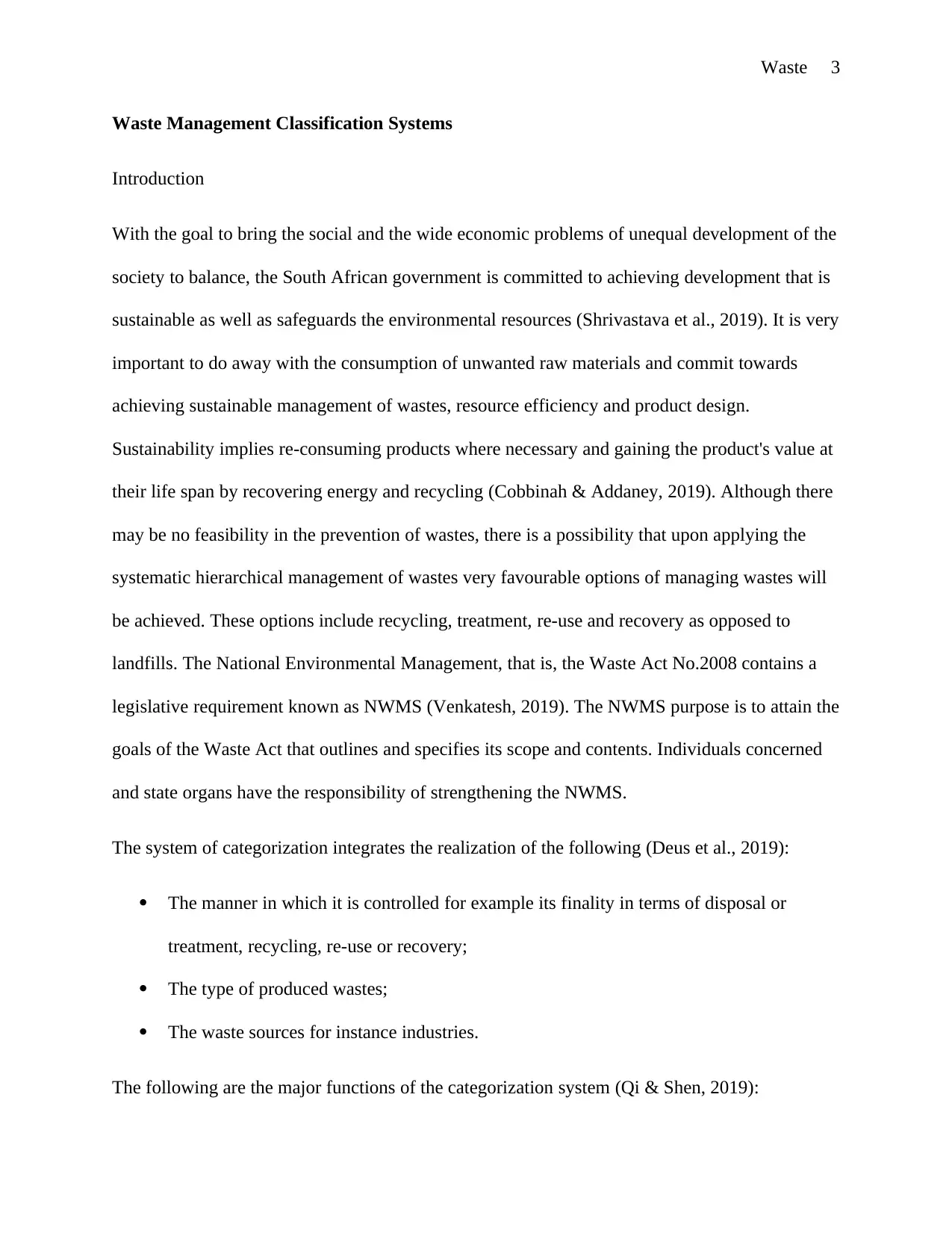
Waste 3
Waste Management Classification Systems
Introduction
With the goal to bring the social and the wide economic problems of unequal development of the
society to balance, the South African government is committed to achieving development that is
sustainable as well as safeguards the environmental resources (Shrivastava et al., 2019). It is very
important to do away with the consumption of unwanted raw materials and commit towards
achieving sustainable management of wastes, resource efficiency and product design.
Sustainability implies re-consuming products where necessary and gaining the product's value at
their life span by recovering energy and recycling (Cobbinah & Addaney, 2019). Although there
may be no feasibility in the prevention of wastes, there is a possibility that upon applying the
systematic hierarchical management of wastes very favourable options of managing wastes will
be achieved. These options include recycling, treatment, re-use and recovery as opposed to
landfills. The National Environmental Management, that is, the Waste Act No.2008 contains a
legislative requirement known as NWMS (Venkatesh, 2019). The NWMS purpose is to attain the
goals of the Waste Act that outlines and specifies its scope and contents. Individuals concerned
and state organs have the responsibility of strengthening the NWMS.
The system of categorization integrates the realization of the following (Deus et al., 2019):
The manner in which it is controlled for example its finality in terms of disposal or
treatment, recycling, re-use or recovery;
The type of produced wastes;
The waste sources for instance industries.
The following are the major functions of the categorization system (Qi & Shen, 2019):
Waste Management Classification Systems
Introduction
With the goal to bring the social and the wide economic problems of unequal development of the
society to balance, the South African government is committed to achieving development that is
sustainable as well as safeguards the environmental resources (Shrivastava et al., 2019). It is very
important to do away with the consumption of unwanted raw materials and commit towards
achieving sustainable management of wastes, resource efficiency and product design.
Sustainability implies re-consuming products where necessary and gaining the product's value at
their life span by recovering energy and recycling (Cobbinah & Addaney, 2019). Although there
may be no feasibility in the prevention of wastes, there is a possibility that upon applying the
systematic hierarchical management of wastes very favourable options of managing wastes will
be achieved. These options include recycling, treatment, re-use and recovery as opposed to
landfills. The National Environmental Management, that is, the Waste Act No.2008 contains a
legislative requirement known as NWMS (Venkatesh, 2019). The NWMS purpose is to attain the
goals of the Waste Act that outlines and specifies its scope and contents. Individuals concerned
and state organs have the responsibility of strengthening the NWMS.
The system of categorization integrates the realization of the following (Deus et al., 2019):
The manner in which it is controlled for example its finality in terms of disposal or
treatment, recycling, re-use or recovery;
The type of produced wastes;
The waste sources for instance industries.
The following are the major functions of the categorization system (Qi & Shen, 2019):
⊘ This is a preview!⊘
Do you want full access?
Subscribe today to unlock all pages.

Trusted by 1+ million students worldwide
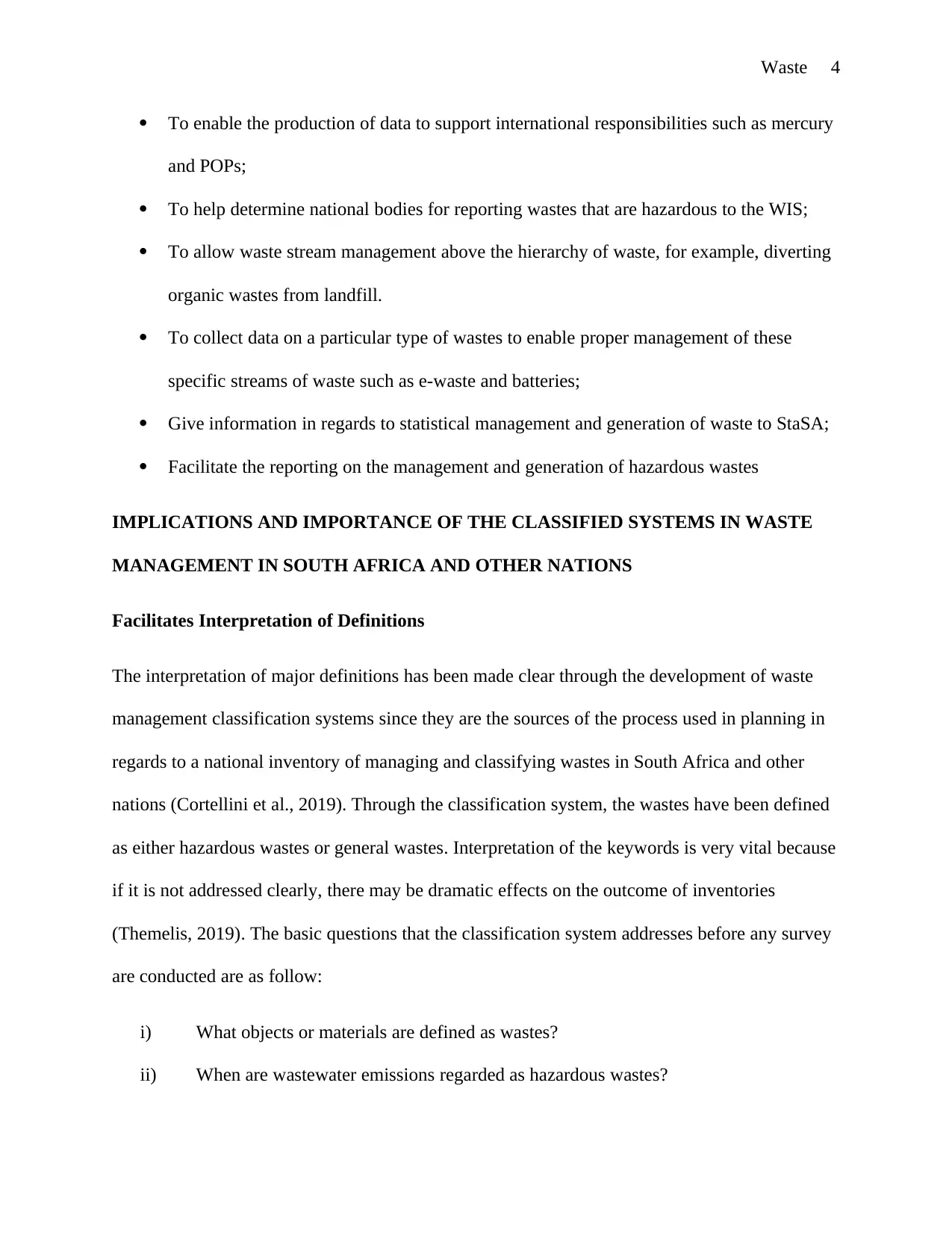
Waste 4
To enable the production of data to support international responsibilities such as mercury
and POPs;
To help determine national bodies for reporting wastes that are hazardous to the WIS;
To allow waste stream management above the hierarchy of waste, for example, diverting
organic wastes from landfill.
To collect data on a particular type of wastes to enable proper management of these
specific streams of waste such as e-waste and batteries;
Give information in regards to statistical management and generation of waste to StaSA;
Facilitate the reporting on the management and generation of hazardous wastes
IMPLICATIONS AND IMPORTANCE OF THE CLASSIFIED SYSTEMS IN WASTE
MANAGEMENT IN SOUTH AFRICA AND OTHER NATIONS
Facilitates Interpretation of Definitions
The interpretation of major definitions has been made clear through the development of waste
management classification systems since they are the sources of the process used in planning in
regards to a national inventory of managing and classifying wastes in South Africa and other
nations (Cortellini et al., 2019). Through the classification system, the wastes have been defined
as either hazardous wastes or general wastes. Interpretation of the keywords is very vital because
if it is not addressed clearly, there may be dramatic effects on the outcome of inventories
(Themelis, 2019). The basic questions that the classification system addresses before any survey
are conducted are as follow:
i) What objects or materials are defined as wastes?
ii) When are wastewater emissions regarded as hazardous wastes?
To enable the production of data to support international responsibilities such as mercury
and POPs;
To help determine national bodies for reporting wastes that are hazardous to the WIS;
To allow waste stream management above the hierarchy of waste, for example, diverting
organic wastes from landfill.
To collect data on a particular type of wastes to enable proper management of these
specific streams of waste such as e-waste and batteries;
Give information in regards to statistical management and generation of waste to StaSA;
Facilitate the reporting on the management and generation of hazardous wastes
IMPLICATIONS AND IMPORTANCE OF THE CLASSIFIED SYSTEMS IN WASTE
MANAGEMENT IN SOUTH AFRICA AND OTHER NATIONS
Facilitates Interpretation of Definitions
The interpretation of major definitions has been made clear through the development of waste
management classification systems since they are the sources of the process used in planning in
regards to a national inventory of managing and classifying wastes in South Africa and other
nations (Cortellini et al., 2019). Through the classification system, the wastes have been defined
as either hazardous wastes or general wastes. Interpretation of the keywords is very vital because
if it is not addressed clearly, there may be dramatic effects on the outcome of inventories
(Themelis, 2019). The basic questions that the classification system addresses before any survey
are conducted are as follow:
i) What objects or materials are defined as wastes?
ii) When are wastewater emissions regarded as hazardous wastes?
Paraphrase This Document
Need a fresh take? Get an instant paraphrase of this document with our AI Paraphraser
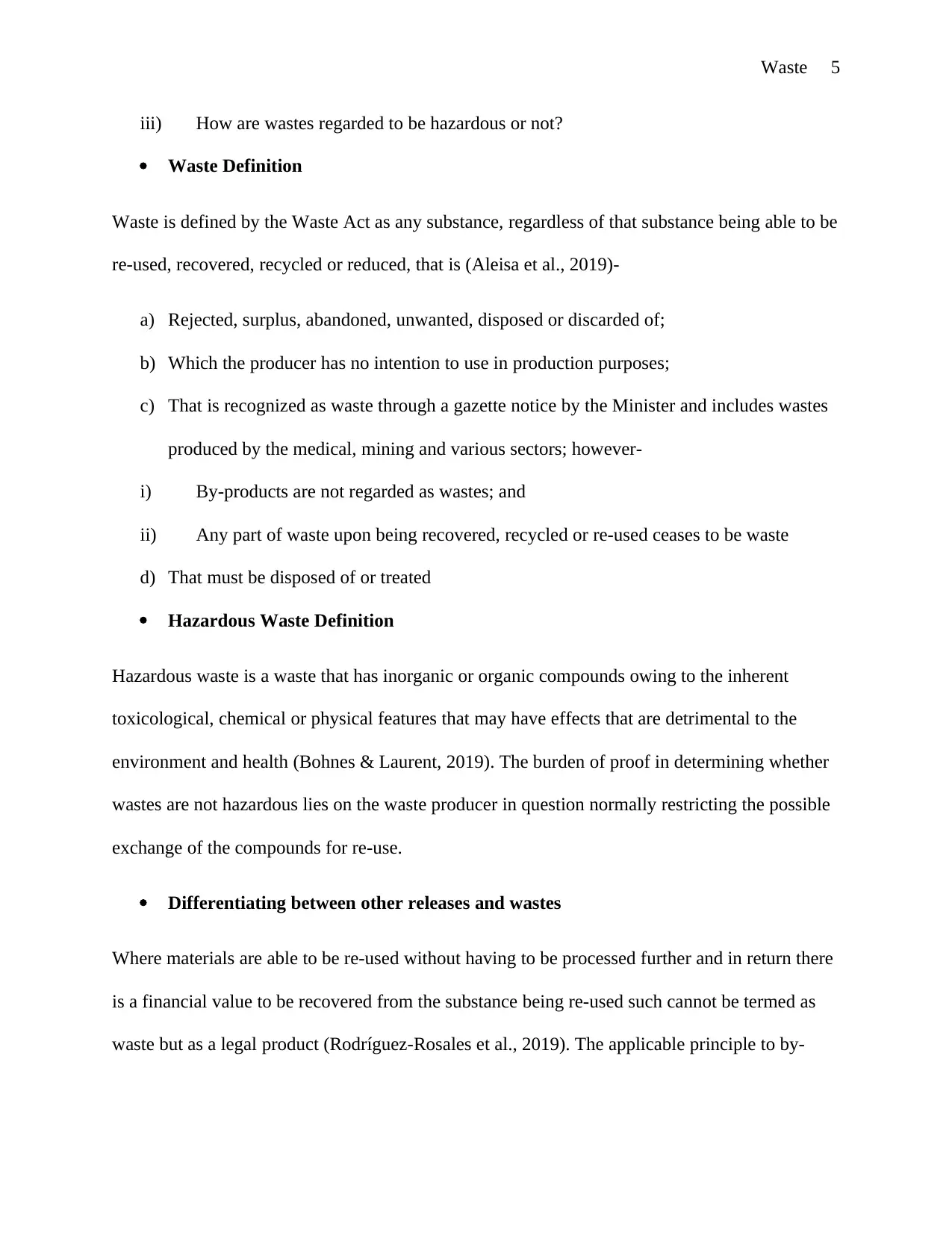
Waste 5
iii) How are wastes regarded to be hazardous or not?
Waste Definition
Waste is defined by the Waste Act as any substance, regardless of that substance being able to be
re-used, recovered, recycled or reduced, that is (Aleisa et al., 2019)-
a) Rejected, surplus, abandoned, unwanted, disposed or discarded of;
b) Which the producer has no intention to use in production purposes;
c) That is recognized as waste through a gazette notice by the Minister and includes wastes
produced by the medical, mining and various sectors; however-
i) By-products are not regarded as wastes; and
ii) Any part of waste upon being recovered, recycled or re-used ceases to be waste
d) That must be disposed of or treated
Hazardous Waste Definition
Hazardous waste is a waste that has inorganic or organic compounds owing to the inherent
toxicological, chemical or physical features that may have effects that are detrimental to the
environment and health (Bohnes & Laurent, 2019). The burden of proof in determining whether
wastes are not hazardous lies on the waste producer in question normally restricting the possible
exchange of the compounds for re-use.
Differentiating between other releases and wastes
Where materials are able to be re-used without having to be processed further and in return there
is a financial value to be recovered from the substance being re-used such cannot be termed as
waste but as a legal product (Rodríguez-Rosales et al., 2019). The applicable principle to by-
iii) How are wastes regarded to be hazardous or not?
Waste Definition
Waste is defined by the Waste Act as any substance, regardless of that substance being able to be
re-used, recovered, recycled or reduced, that is (Aleisa et al., 2019)-
a) Rejected, surplus, abandoned, unwanted, disposed or discarded of;
b) Which the producer has no intention to use in production purposes;
c) That is recognized as waste through a gazette notice by the Minister and includes wastes
produced by the medical, mining and various sectors; however-
i) By-products are not regarded as wastes; and
ii) Any part of waste upon being recovered, recycled or re-used ceases to be waste
d) That must be disposed of or treated
Hazardous Waste Definition
Hazardous waste is a waste that has inorganic or organic compounds owing to the inherent
toxicological, chemical or physical features that may have effects that are detrimental to the
environment and health (Bohnes & Laurent, 2019). The burden of proof in determining whether
wastes are not hazardous lies on the waste producer in question normally restricting the possible
exchange of the compounds for re-use.
Differentiating between other releases and wastes
Where materials are able to be re-used without having to be processed further and in return there
is a financial value to be recovered from the substance being re-used such cannot be termed as
waste but as a legal product (Rodríguez-Rosales et al., 2019). The applicable principle to by-
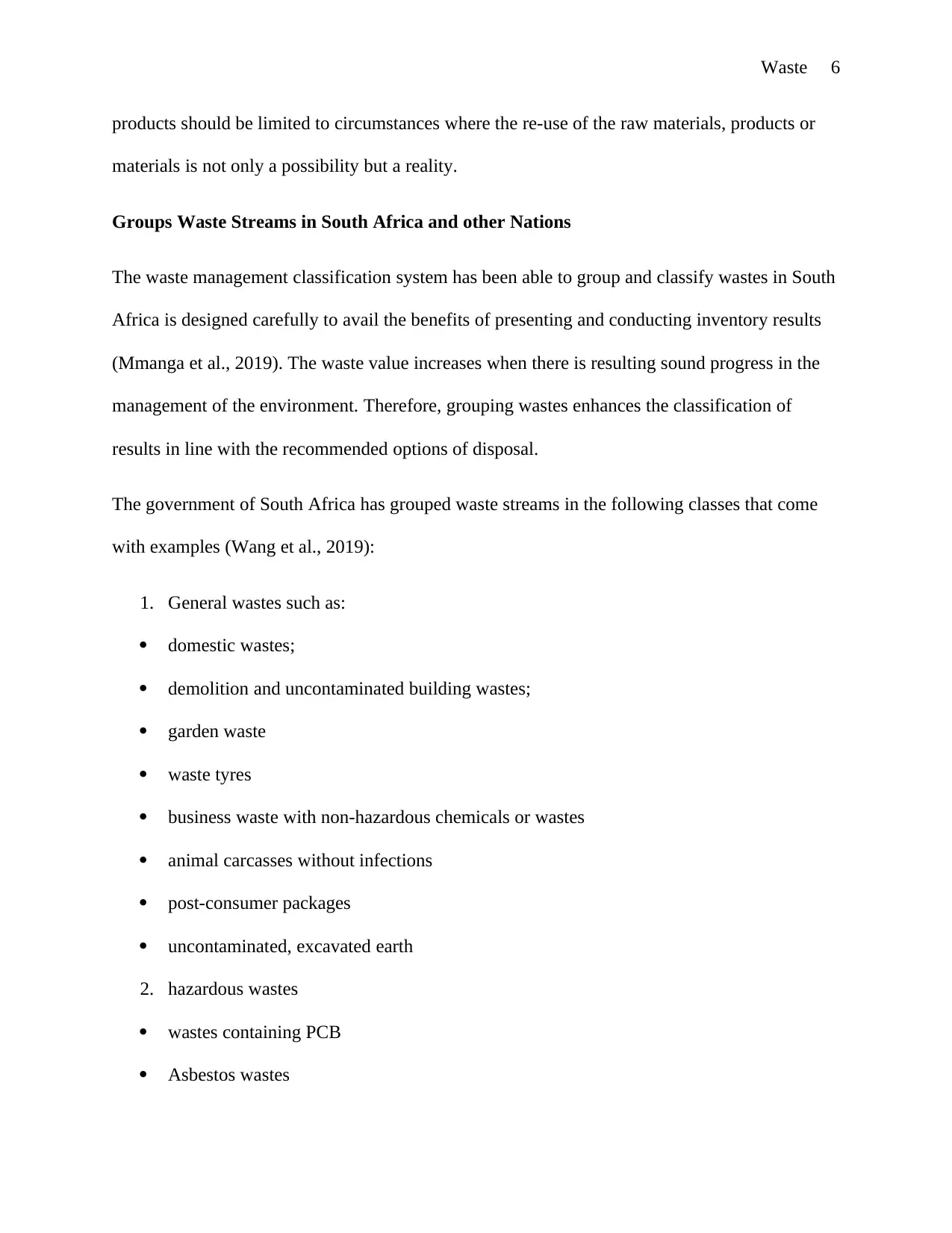
Waste 6
products should be limited to circumstances where the re-use of the raw materials, products or
materials is not only a possibility but a reality.
Groups Waste Streams in South Africa and other Nations
The waste management classification system has been able to group and classify wastes in South
Africa is designed carefully to avail the benefits of presenting and conducting inventory results
(Mmanga et al., 2019). The waste value increases when there is resulting sound progress in the
management of the environment. Therefore, grouping wastes enhances the classification of
results in line with the recommended options of disposal.
The government of South Africa has grouped waste streams in the following classes that come
with examples (Wang et al., 2019):
1. General wastes such as:
domestic wastes;
demolition and uncontaminated building wastes;
garden waste
waste tyres
business waste with non-hazardous chemicals or wastes
animal carcasses without infections
post-consumer packages
uncontaminated, excavated earth
2. hazardous wastes
wastes containing PCB
Asbestos wastes
products should be limited to circumstances where the re-use of the raw materials, products or
materials is not only a possibility but a reality.
Groups Waste Streams in South Africa and other Nations
The waste management classification system has been able to group and classify wastes in South
Africa is designed carefully to avail the benefits of presenting and conducting inventory results
(Mmanga et al., 2019). The waste value increases when there is resulting sound progress in the
management of the environment. Therefore, grouping wastes enhances the classification of
results in line with the recommended options of disposal.
The government of South Africa has grouped waste streams in the following classes that come
with examples (Wang et al., 2019):
1. General wastes such as:
domestic wastes;
demolition and uncontaminated building wastes;
garden waste
waste tyres
business waste with non-hazardous chemicals or wastes
animal carcasses without infections
post-consumer packages
uncontaminated, excavated earth
2. hazardous wastes
wastes containing PCB
Asbestos wastes
⊘ This is a preview!⊘
Do you want full access?
Subscribe today to unlock all pages.

Trusted by 1+ million students worldwide
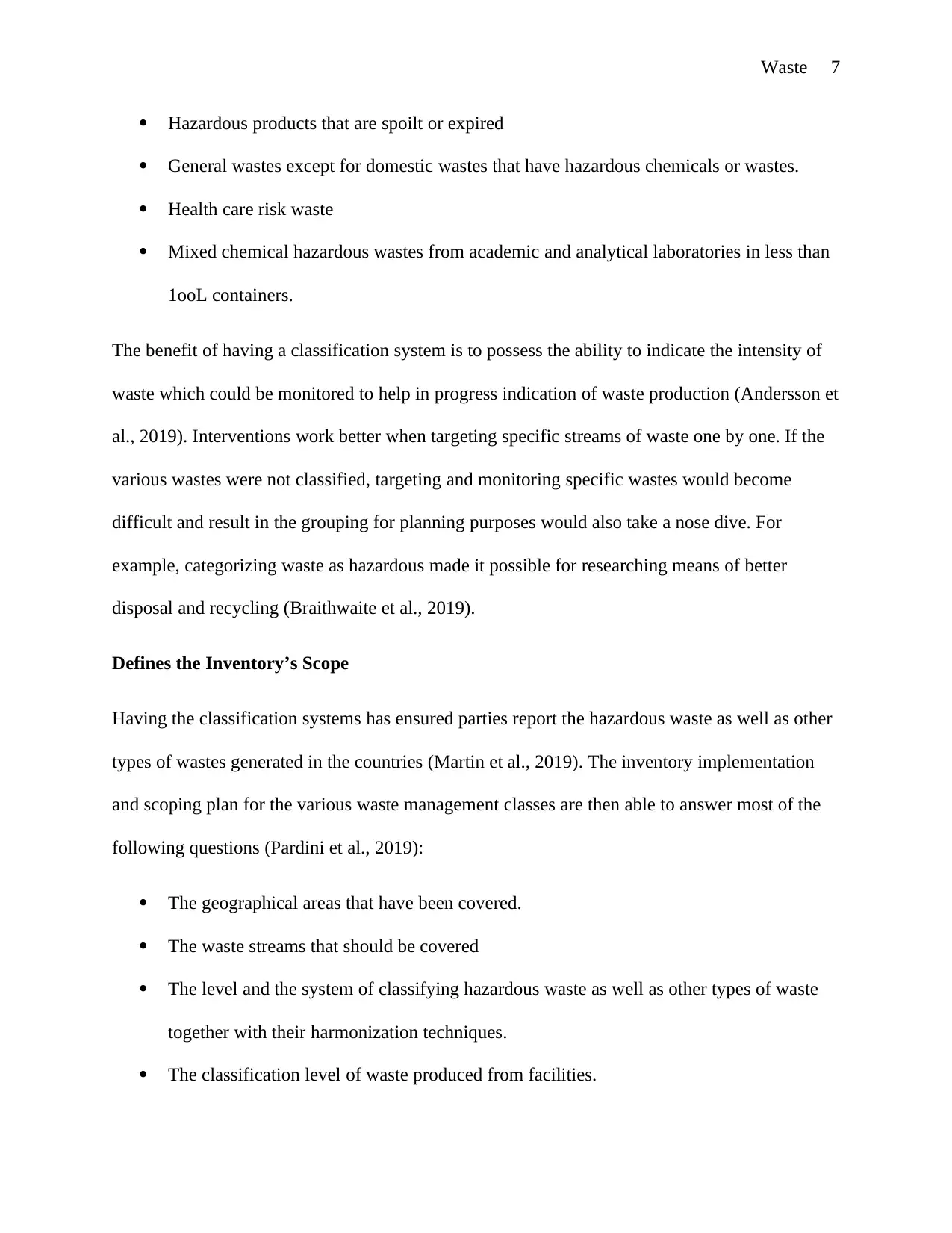
Waste 7
Hazardous products that are spoilt or expired
General wastes except for domestic wastes that have hazardous chemicals or wastes.
Health care risk waste
Mixed chemical hazardous wastes from academic and analytical laboratories in less than
1ooL containers.
The benefit of having a classification system is to possess the ability to indicate the intensity of
waste which could be monitored to help in progress indication of waste production (Andersson et
al., 2019). Interventions work better when targeting specific streams of waste one by one. If the
various wastes were not classified, targeting and monitoring specific wastes would become
difficult and result in the grouping for planning purposes would also take a nose dive. For
example, categorizing waste as hazardous made it possible for researching means of better
disposal and recycling (Braithwaite et al., 2019).
Defines the Inventory’s Scope
Having the classification systems has ensured parties report the hazardous waste as well as other
types of wastes generated in the countries (Martin et al., 2019). The inventory implementation
and scoping plan for the various waste management classes are then able to answer most of the
following questions (Pardini et al., 2019):
The geographical areas that have been covered.
The waste streams that should be covered
The level and the system of classifying hazardous waste as well as other types of waste
together with their harmonization techniques.
The classification level of waste produced from facilities.
Hazardous products that are spoilt or expired
General wastes except for domestic wastes that have hazardous chemicals or wastes.
Health care risk waste
Mixed chemical hazardous wastes from academic and analytical laboratories in less than
1ooL containers.
The benefit of having a classification system is to possess the ability to indicate the intensity of
waste which could be monitored to help in progress indication of waste production (Andersson et
al., 2019). Interventions work better when targeting specific streams of waste one by one. If the
various wastes were not classified, targeting and monitoring specific wastes would become
difficult and result in the grouping for planning purposes would also take a nose dive. For
example, categorizing waste as hazardous made it possible for researching means of better
disposal and recycling (Braithwaite et al., 2019).
Defines the Inventory’s Scope
Having the classification systems has ensured parties report the hazardous waste as well as other
types of wastes generated in the countries (Martin et al., 2019). The inventory implementation
and scoping plan for the various waste management classes are then able to answer most of the
following questions (Pardini et al., 2019):
The geographical areas that have been covered.
The waste streams that should be covered
The level and the system of classifying hazardous waste as well as other types of waste
together with their harmonization techniques.
The classification level of waste produced from facilities.
Paraphrase This Document
Need a fresh take? Get an instant paraphrase of this document with our AI Paraphraser
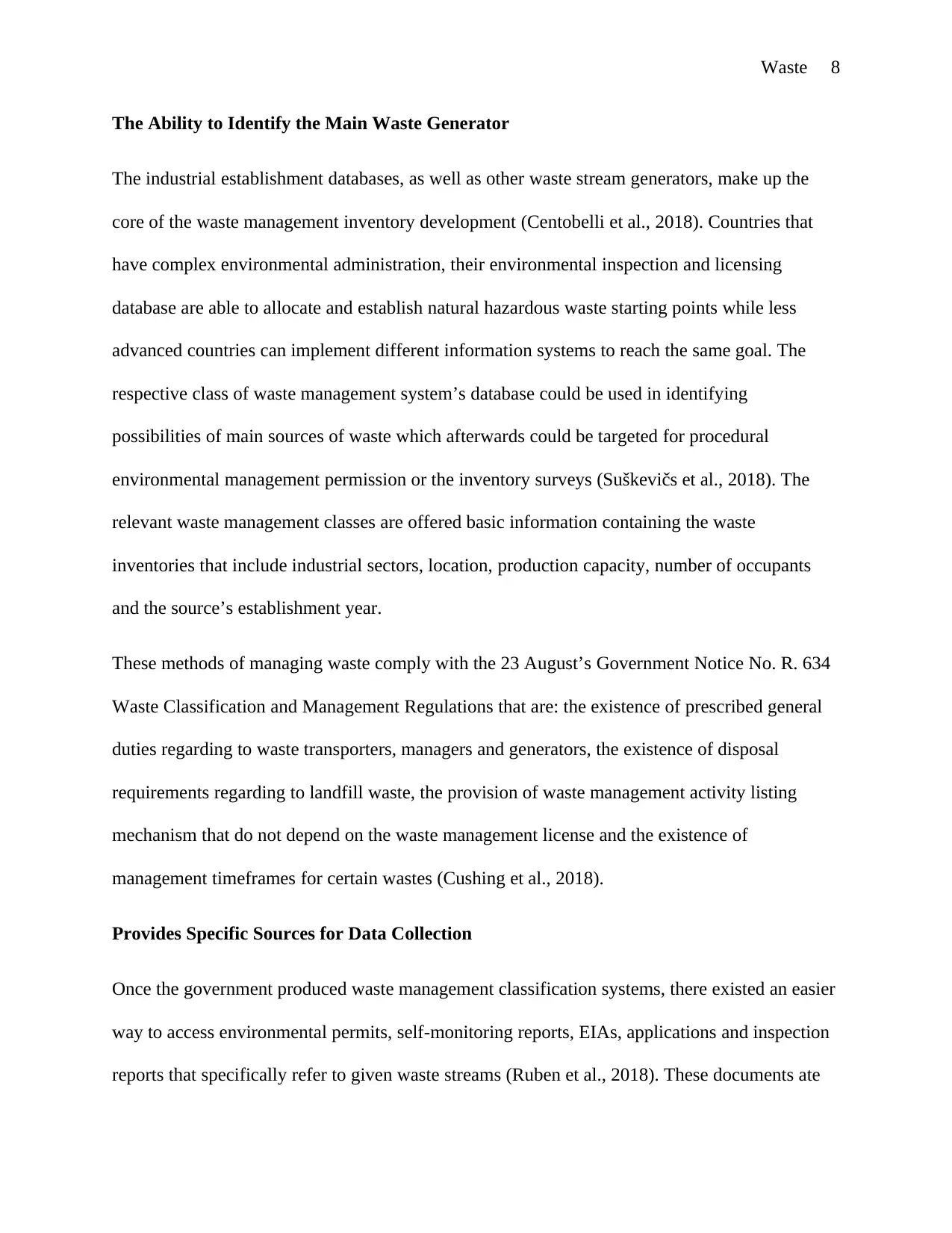
Waste 8
The Ability to Identify the Main Waste Generator
The industrial establishment databases, as well as other waste stream generators, make up the
core of the waste management inventory development (Centobelli et al., 2018). Countries that
have complex environmental administration, their environmental inspection and licensing
database are able to allocate and establish natural hazardous waste starting points while less
advanced countries can implement different information systems to reach the same goal. The
respective class of waste management system’s database could be used in identifying
possibilities of main sources of waste which afterwards could be targeted for procedural
environmental management permission or the inventory surveys (Suškevičs et al., 2018). The
relevant waste management classes are offered basic information containing the waste
inventories that include industrial sectors, location, production capacity, number of occupants
and the source’s establishment year.
These methods of managing waste comply with the 23 August’s Government Notice No. R. 634
Waste Classification and Management Regulations that are: the existence of prescribed general
duties regarding to waste transporters, managers and generators, the existence of disposal
requirements regarding to landfill waste, the provision of waste management activity listing
mechanism that do not depend on the waste management license and the existence of
management timeframes for certain wastes (Cushing et al., 2018).
Provides Specific Sources for Data Collection
Once the government produced waste management classification systems, there existed an easier
way to access environmental permits, self-monitoring reports, EIAs, applications and inspection
reports that specifically refer to given waste streams (Ruben et al., 2018). These documents ate
The Ability to Identify the Main Waste Generator
The industrial establishment databases, as well as other waste stream generators, make up the
core of the waste management inventory development (Centobelli et al., 2018). Countries that
have complex environmental administration, their environmental inspection and licensing
database are able to allocate and establish natural hazardous waste starting points while less
advanced countries can implement different information systems to reach the same goal. The
respective class of waste management system’s database could be used in identifying
possibilities of main sources of waste which afterwards could be targeted for procedural
environmental management permission or the inventory surveys (Suškevičs et al., 2018). The
relevant waste management classes are offered basic information containing the waste
inventories that include industrial sectors, location, production capacity, number of occupants
and the source’s establishment year.
These methods of managing waste comply with the 23 August’s Government Notice No. R. 634
Waste Classification and Management Regulations that are: the existence of prescribed general
duties regarding to waste transporters, managers and generators, the existence of disposal
requirements regarding to landfill waste, the provision of waste management activity listing
mechanism that do not depend on the waste management license and the existence of
management timeframes for certain wastes (Cushing et al., 2018).
Provides Specific Sources for Data Collection
Once the government produced waste management classification systems, there existed an easier
way to access environmental permits, self-monitoring reports, EIAs, applications and inspection
reports that specifically refer to given waste streams (Ruben et al., 2018). These documents ate
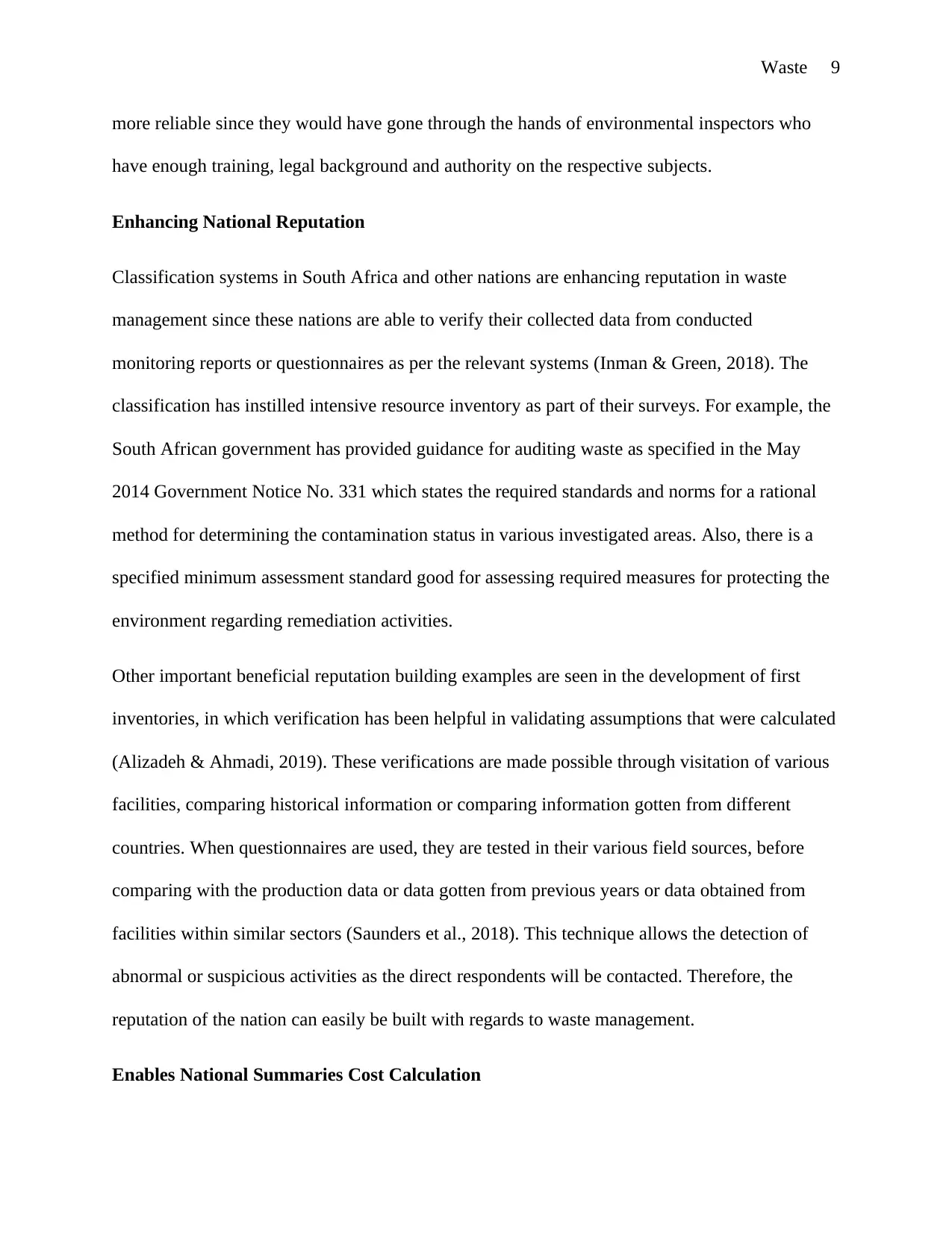
Waste 9
more reliable since they would have gone through the hands of environmental inspectors who
have enough training, legal background and authority on the respective subjects.
Enhancing National Reputation
Classification systems in South Africa and other nations are enhancing reputation in waste
management since these nations are able to verify their collected data from conducted
monitoring reports or questionnaires as per the relevant systems (Inman & Green, 2018). The
classification has instilled intensive resource inventory as part of their surveys. For example, the
South African government has provided guidance for auditing waste as specified in the May
2014 Government Notice No. 331 which states the required standards and norms for a rational
method for determining the contamination status in various investigated areas. Also, there is a
specified minimum assessment standard good for assessing required measures for protecting the
environment regarding remediation activities.
Other important beneficial reputation building examples are seen in the development of first
inventories, in which verification has been helpful in validating assumptions that were calculated
(Alizadeh & Ahmadi, 2019). These verifications are made possible through visitation of various
facilities, comparing historical information or comparing information gotten from different
countries. When questionnaires are used, they are tested in their various field sources, before
comparing with the production data or data gotten from previous years or data obtained from
facilities within similar sectors (Saunders et al., 2018). This technique allows the detection of
abnormal or suspicious activities as the direct respondents will be contacted. Therefore, the
reputation of the nation can easily be built with regards to waste management.
Enables National Summaries Cost Calculation
more reliable since they would have gone through the hands of environmental inspectors who
have enough training, legal background and authority on the respective subjects.
Enhancing National Reputation
Classification systems in South Africa and other nations are enhancing reputation in waste
management since these nations are able to verify their collected data from conducted
monitoring reports or questionnaires as per the relevant systems (Inman & Green, 2018). The
classification has instilled intensive resource inventory as part of their surveys. For example, the
South African government has provided guidance for auditing waste as specified in the May
2014 Government Notice No. 331 which states the required standards and norms for a rational
method for determining the contamination status in various investigated areas. Also, there is a
specified minimum assessment standard good for assessing required measures for protecting the
environment regarding remediation activities.
Other important beneficial reputation building examples are seen in the development of first
inventories, in which verification has been helpful in validating assumptions that were calculated
(Alizadeh & Ahmadi, 2019). These verifications are made possible through visitation of various
facilities, comparing historical information or comparing information gotten from different
countries. When questionnaires are used, they are tested in their various field sources, before
comparing with the production data or data gotten from previous years or data obtained from
facilities within similar sectors (Saunders et al., 2018). This technique allows the detection of
abnormal or suspicious activities as the direct respondents will be contacted. Therefore, the
reputation of the nation can easily be built with regards to waste management.
Enables National Summaries Cost Calculation
⊘ This is a preview!⊘
Do you want full access?
Subscribe today to unlock all pages.

Trusted by 1+ million students worldwide
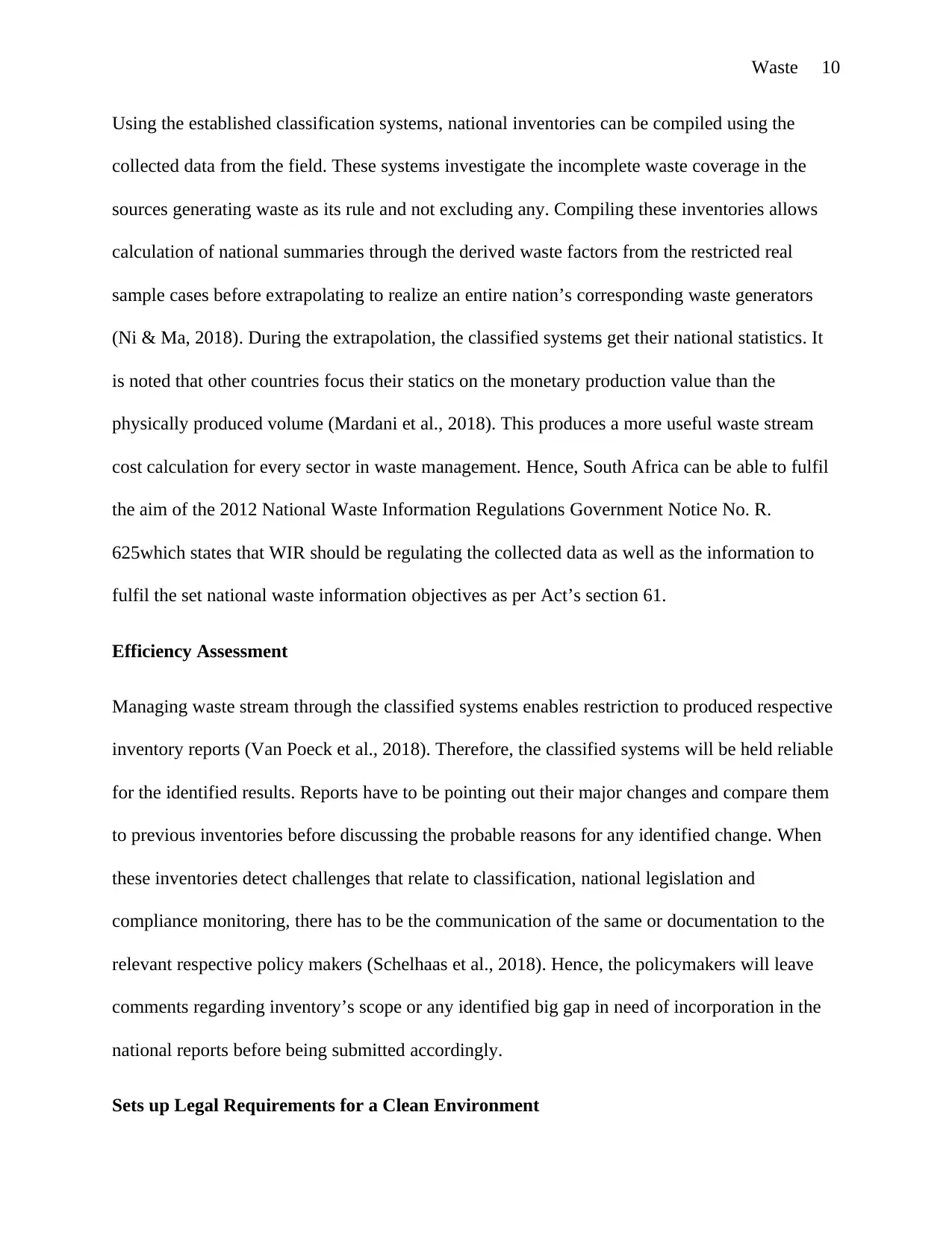
Waste 10
Using the established classification systems, national inventories can be compiled using the
collected data from the field. These systems investigate the incomplete waste coverage in the
sources generating waste as its rule and not excluding any. Compiling these inventories allows
calculation of national summaries through the derived waste factors from the restricted real
sample cases before extrapolating to realize an entire nation’s corresponding waste generators
(Ni & Ma, 2018). During the extrapolation, the classified systems get their national statistics. It
is noted that other countries focus their statics on the monetary production value than the
physically produced volume (Mardani et al., 2018). This produces a more useful waste stream
cost calculation for every sector in waste management. Hence, South Africa can be able to fulfil
the aim of the 2012 National Waste Information Regulations Government Notice No. R.
625which states that WIR should be regulating the collected data as well as the information to
fulfil the set national waste information objectives as per Act’s section 61.
Efficiency Assessment
Managing waste stream through the classified systems enables restriction to produced respective
inventory reports (Van Poeck et al., 2018). Therefore, the classified systems will be held reliable
for the identified results. Reports have to be pointing out their major changes and compare them
to previous inventories before discussing the probable reasons for any identified change. When
these inventories detect challenges that relate to classification, national legislation and
compliance monitoring, there has to be the communication of the same or documentation to the
relevant respective policy makers (Schelhaas et al., 2018). Hence, the policymakers will leave
comments regarding inventory’s scope or any identified big gap in need of incorporation in the
national reports before being submitted accordingly.
Sets up Legal Requirements for a Clean Environment
Using the established classification systems, national inventories can be compiled using the
collected data from the field. These systems investigate the incomplete waste coverage in the
sources generating waste as its rule and not excluding any. Compiling these inventories allows
calculation of national summaries through the derived waste factors from the restricted real
sample cases before extrapolating to realize an entire nation’s corresponding waste generators
(Ni & Ma, 2018). During the extrapolation, the classified systems get their national statistics. It
is noted that other countries focus their statics on the monetary production value than the
physically produced volume (Mardani et al., 2018). This produces a more useful waste stream
cost calculation for every sector in waste management. Hence, South Africa can be able to fulfil
the aim of the 2012 National Waste Information Regulations Government Notice No. R.
625which states that WIR should be regulating the collected data as well as the information to
fulfil the set national waste information objectives as per Act’s section 61.
Efficiency Assessment
Managing waste stream through the classified systems enables restriction to produced respective
inventory reports (Van Poeck et al., 2018). Therefore, the classified systems will be held reliable
for the identified results. Reports have to be pointing out their major changes and compare them
to previous inventories before discussing the probable reasons for any identified change. When
these inventories detect challenges that relate to classification, national legislation and
compliance monitoring, there has to be the communication of the same or documentation to the
relevant respective policy makers (Schelhaas et al., 2018). Hence, the policymakers will leave
comments regarding inventory’s scope or any identified big gap in need of incorporation in the
national reports before being submitted accordingly.
Sets up Legal Requirements for a Clean Environment
Paraphrase This Document
Need a fresh take? Get an instant paraphrase of this document with our AI Paraphraser
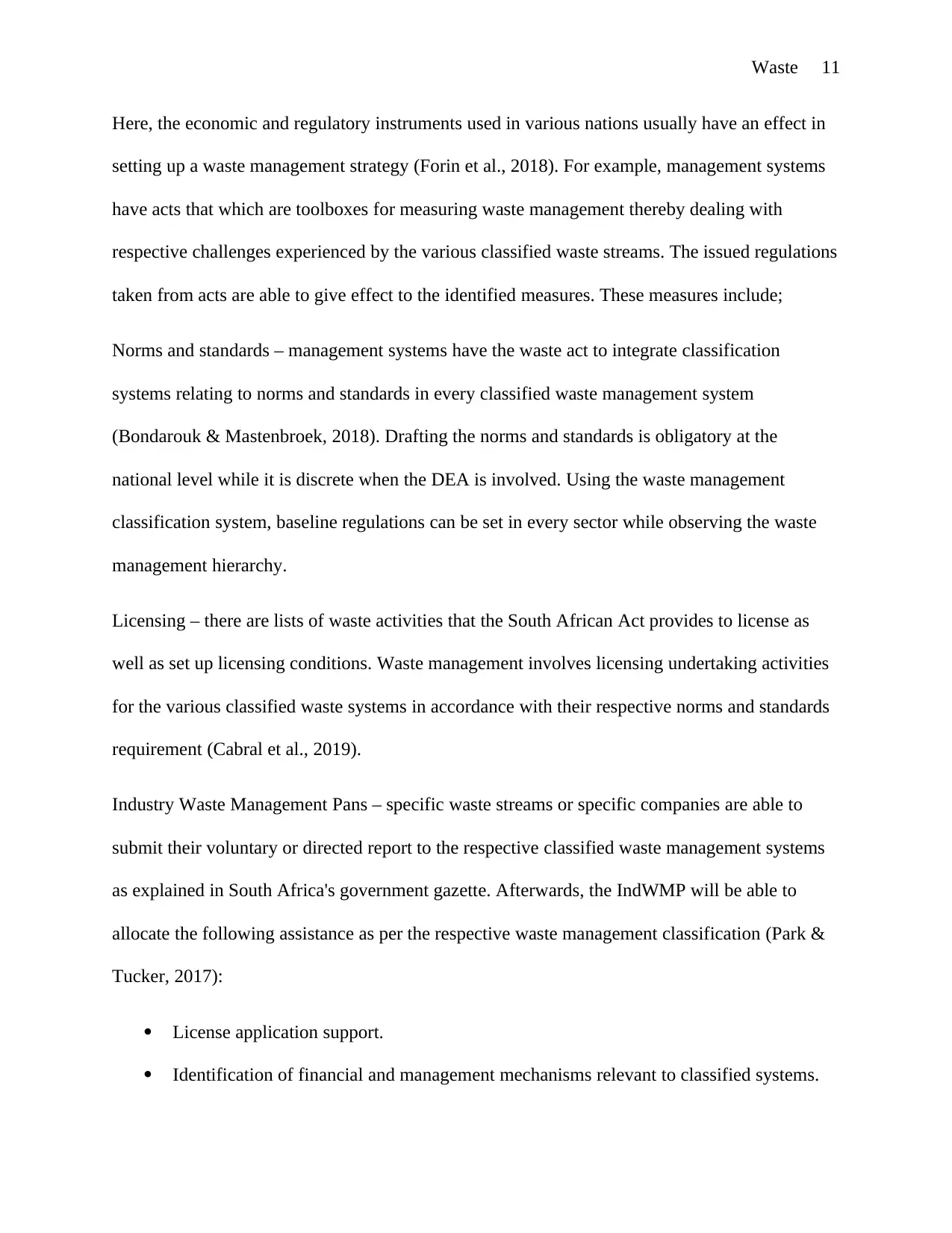
Waste 11
Here, the economic and regulatory instruments used in various nations usually have an effect in
setting up a waste management strategy (Forin et al., 2018). For example, management systems
have acts that which are toolboxes for measuring waste management thereby dealing with
respective challenges experienced by the various classified waste streams. The issued regulations
taken from acts are able to give effect to the identified measures. These measures include;
Norms and standards – management systems have the waste act to integrate classification
systems relating to norms and standards in every classified waste management system
(Bondarouk & Mastenbroek, 2018). Drafting the norms and standards is obligatory at the
national level while it is discrete when the DEA is involved. Using the waste management
classification system, baseline regulations can be set in every sector while observing the waste
management hierarchy.
Licensing – there are lists of waste activities that the South African Act provides to license as
well as set up licensing conditions. Waste management involves licensing undertaking activities
for the various classified waste systems in accordance with their respective norms and standards
requirement (Cabral et al., 2019).
Industry Waste Management Pans – specific waste streams or specific companies are able to
submit their voluntary or directed report to the respective classified waste management systems
as explained in South Africa's government gazette. Afterwards, the IndWMP will be able to
allocate the following assistance as per the respective waste management classification (Park &
Tucker, 2017):
License application support.
Identification of financial and management mechanisms relevant to classified systems.
Here, the economic and regulatory instruments used in various nations usually have an effect in
setting up a waste management strategy (Forin et al., 2018). For example, management systems
have acts that which are toolboxes for measuring waste management thereby dealing with
respective challenges experienced by the various classified waste streams. The issued regulations
taken from acts are able to give effect to the identified measures. These measures include;
Norms and standards – management systems have the waste act to integrate classification
systems relating to norms and standards in every classified waste management system
(Bondarouk & Mastenbroek, 2018). Drafting the norms and standards is obligatory at the
national level while it is discrete when the DEA is involved. Using the waste management
classification system, baseline regulations can be set in every sector while observing the waste
management hierarchy.
Licensing – there are lists of waste activities that the South African Act provides to license as
well as set up licensing conditions. Waste management involves licensing undertaking activities
for the various classified waste systems in accordance with their respective norms and standards
requirement (Cabral et al., 2019).
Industry Waste Management Pans – specific waste streams or specific companies are able to
submit their voluntary or directed report to the respective classified waste management systems
as explained in South Africa's government gazette. Afterwards, the IndWMP will be able to
allocate the following assistance as per the respective waste management classification (Park &
Tucker, 2017):
License application support.
Identification of financial and management mechanisms relevant to classified systems.
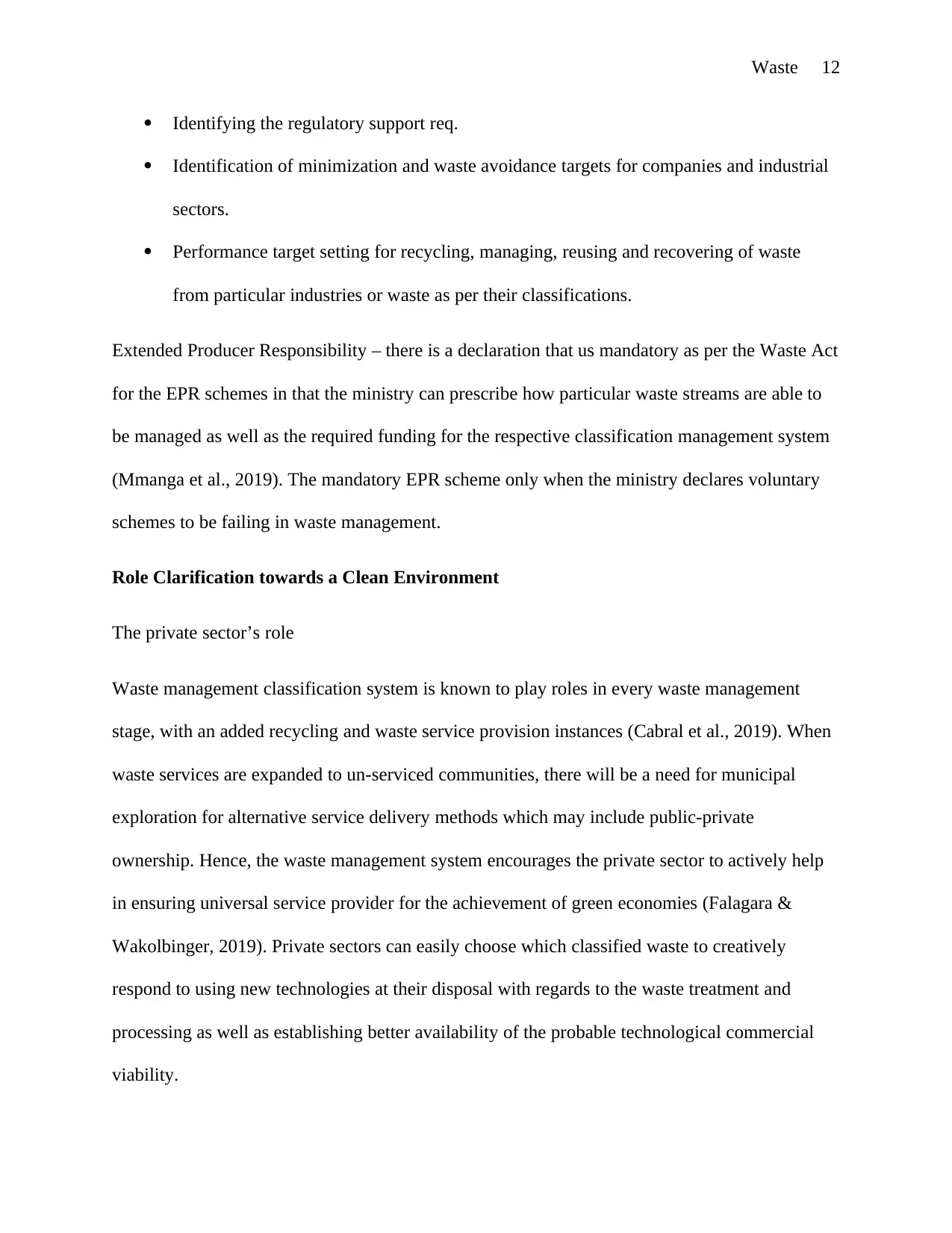
Waste 12
Identifying the regulatory support req.
Identification of minimization and waste avoidance targets for companies and industrial
sectors.
Performance target setting for recycling, managing, reusing and recovering of waste
from particular industries or waste as per their classifications.
Extended Producer Responsibility – there is a declaration that us mandatory as per the Waste Act
for the EPR schemes in that the ministry can prescribe how particular waste streams are able to
be managed as well as the required funding for the respective classification management system
(Mmanga et al., 2019). The mandatory EPR scheme only when the ministry declares voluntary
schemes to be failing in waste management.
Role Clarification towards a Clean Environment
The private sector’s role
Waste management classification system is known to play roles in every waste management
stage, with an added recycling and waste service provision instances (Cabral et al., 2019). When
waste services are expanded to un-serviced communities, there will be a need for municipal
exploration for alternative service delivery methods which may include public-private
ownership. Hence, the waste management system encourages the private sector to actively help
in ensuring universal service provider for the achievement of green economies (Falagara &
Wakolbinger, 2019). Private sectors can easily choose which classified waste to creatively
respond to using new technologies at their disposal with regards to the waste treatment and
processing as well as establishing better availability of the probable technological commercial
viability.
Identifying the regulatory support req.
Identification of minimization and waste avoidance targets for companies and industrial
sectors.
Performance target setting for recycling, managing, reusing and recovering of waste
from particular industries or waste as per their classifications.
Extended Producer Responsibility – there is a declaration that us mandatory as per the Waste Act
for the EPR schemes in that the ministry can prescribe how particular waste streams are able to
be managed as well as the required funding for the respective classification management system
(Mmanga et al., 2019). The mandatory EPR scheme only when the ministry declares voluntary
schemes to be failing in waste management.
Role Clarification towards a Clean Environment
The private sector’s role
Waste management classification system is known to play roles in every waste management
stage, with an added recycling and waste service provision instances (Cabral et al., 2019). When
waste services are expanded to un-serviced communities, there will be a need for municipal
exploration for alternative service delivery methods which may include public-private
ownership. Hence, the waste management system encourages the private sector to actively help
in ensuring universal service provider for the achievement of green economies (Falagara &
Wakolbinger, 2019). Private sectors can easily choose which classified waste to creatively
respond to using new technologies at their disposal with regards to the waste treatment and
processing as well as establishing better availability of the probable technological commercial
viability.
⊘ This is a preview!⊘
Do you want full access?
Subscribe today to unlock all pages.

Trusted by 1+ million students worldwide
1 out of 20
Your All-in-One AI-Powered Toolkit for Academic Success.
+13062052269
info@desklib.com
Available 24*7 on WhatsApp / Email
![[object Object]](/_next/static/media/star-bottom.7253800d.svg)
Unlock your academic potential
Copyright © 2020–2025 A2Z Services. All Rights Reserved. Developed and managed by ZUCOL.
